Introduction: In this article – to help celebrate October being National Cookbook Month – Gena Philibert-Ortega writes about Lizzie Kander and her “The Settlement Cook Book” and includes recipes. Gena is a genealogist and author of the book “From the Family Kitchen.”
Historical cookbooks are fun to look at, but cooking from them is another story. Recipes for foods that are no longer popular, unpopular ingredients, or lengthy preparations are just some of the reasons that cookbooks fall out of favor.
Cookbooks can seem dated after only a few years, but there are a few cookbooks that have been around for generations that home cooks still report using for favorite recipes or giving as gifts.

A Way to a Man’s Stomach
Long before such well-known classics as The Joy of Cooking and Mastering the Art of French Cooking were published, there was The Settlement Cook Book, whose tag line was “the way to a man’s heart…” Despite this tag line’s promise of keeping or getting a man, the initial purpose grew out of teaching immigrant women to cook in their new homeland.
Written in 1901 by Lizzie Black Kander (Mrs. Simon Kander), the charity cookbook was initially financed by her when the settlement house she worked for denied her request for funding the initial printing. Her first run of 1,000 copies were given to students, with the remainder sold to the public for 50 cents. Sold out within the year, the cookbook has since gone through updates and reprintings over the last 100-plus years. The latest edition was published in 1991.
What was in that first edition?
“The first edition was a 174-page rough draft. No table of contents at the beginning of the volume provided organization for the book’s two sections – 500 heirloom recipes collected from old family cookbooks and the 24 lessons from the Settlement’s cooking classes.” (1)
Unlike some other cookbooks of the day, Kander’s grew out of teaching cooking – so it included instruction in measuring and other “rules” of the kitchen.

The 1903 second edition grew to 187 pages and included an index. The 1991 edition is over 800 pages.
This charity cookbook went beyond Kander’s cooking students and her local community to a wider distribution. By the 1920s it was advertised in newspapers in other states, like this 1922 ad for Michigan’s H.G. Wedland & Co that proclaims the cookbook is:
“A large, carefully compiled, well printed and bound volume, containing tested recipes from the Settlement Cooking Classes, the Milwaukee Public School Kitchen, the School of Trades for Girls and ‘Experienced Housewives.’”
Customers could acquire the book for $2.50.
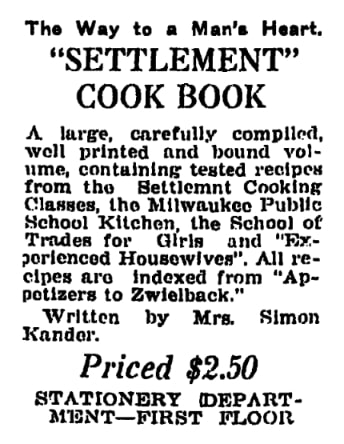
A 1929 advertisement in the Chicago Daily News offers the cookbook for $1.89.
“One of the most reliable and popular cook books. Bound in washable oil cloth.”
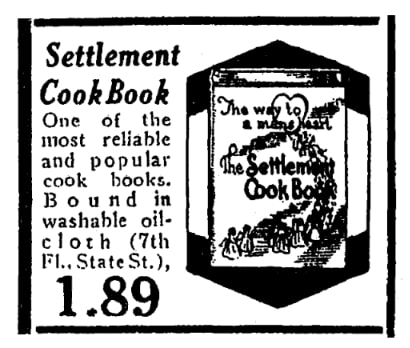
As mentioned above, in addition to recipes, readers were given information about setting the table, keeping things clean, and entertaining. Recipes included in the cookbook span European, Jewish, and American. Each reprinting saw Kander adding to and updating her cookbook.
Kander died in 1940 and by the time of her death, her cookbook had gone through 23 editions, raising $75,000 for what would be the Milwaukee Jewish Center. She had spent her life helping others – but in the end, it was the cookbook that she was most remembered for, as this lengthy Milwaukee Sentinel obituary attests.
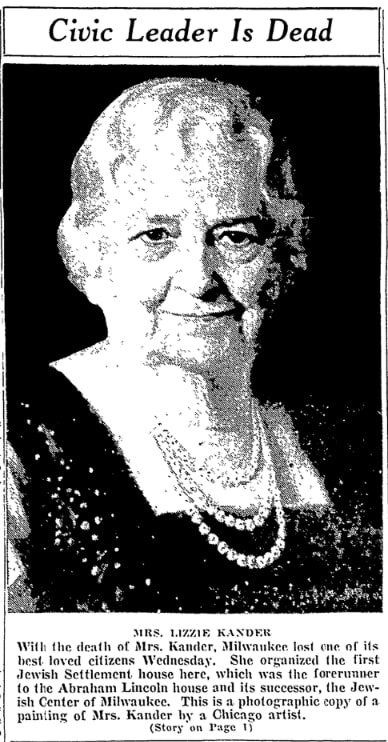
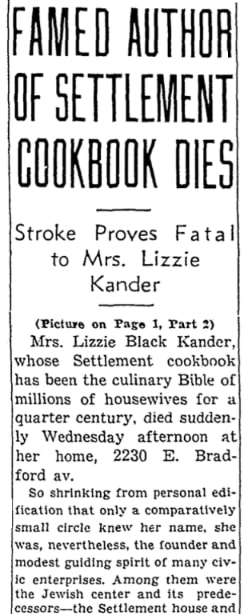
Her great educational contribution was in the kitchen. From the pages of her book, brides in every state of the Union and countless foreign countries have learned to make John forget that “nobody can cook like mother.”
One fan of Kander’s cookbook commented:
“I have this book. My mom made the brownies all the time. I learned to bake from recipes in this book.” (2)
Plans to continue publishing her cookbook were announced after Kander’s death, and have continued decades after.
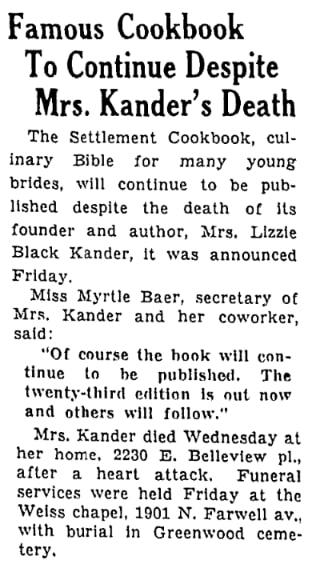
Though sometimes referred to as a “Jewish cookbook,” Kander did not see her work as a Jewish cookbook. She wrote it for everyone looking for a good general cookbook that they could use throughout their lives. Genealogist Bonnie Hayosh said of the cookbook:
“I have the 1965 edition. It is like a text book for a cooking school. Most recipes are basic foods. Lots of charts and diagrams.” (3)
That’s exactly what Kander was hoping for. Asked in 1933 why she thought her cookbook had become so popular, she replied:
“Because The Settlement Cook Book is primarily a home cook book. The recipes are tested in a home kitchen. They are practical, economical, and reliable. The directions are given in simple language and are easy to follow. Because of America’s cosmopolitan population, the dishes of all nationalities have been included.” (4)
Try a Recipe
Don’t have a copy of The Settlement Cookbook? Historical newspapers, such as GenealogyBank’s Historical Newspaper Archives, included recipes from the cookbook. Here are a few you might be interested in.
1951 Marshmallow Dessert Pie
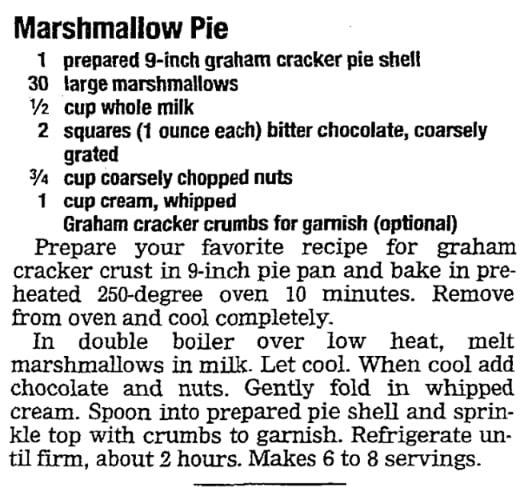
1965 Sweet Potato Pancakes
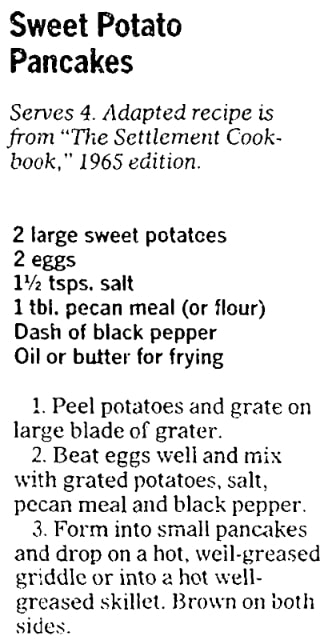
1976 Sauerbraten

Explore over 330 years of newspapers and historical records in GenealogyBank. Discover your family story! Start a 7-Day Free Trial
Note on the header image: photo of Lizzie Kander, “The Settlement Cook Book,” from the author’s collection. Credit: Gena Philibert-Ortega.
____________________
(1) “Object Lesson: Settlement Cookbook,” Wisconsin 101 (https://wi101.wisc.edu/object-history-settlement-cook-book/: accessed 11 October 2023).
(2) Quote by Dina Killan regarding The Settlement Cookbook.
(3) Bonnie Hayosh in response to Facebook post to Gena Philibert-Ortega.
(4) Ibid.

I enjoyed reading this article about cookbooks — all of the old recipes. I am wondering: just how did the women tell how hot the oven was? It was not like today, when you just turn the dial and get 350 degrees to bake anything. Does anyone know?
You’re right, Mary, the oven temperature gauge is relatively new. I’m not sure how women knew what temperature their oven was. I bet historical newspapers may have articles on that topic.